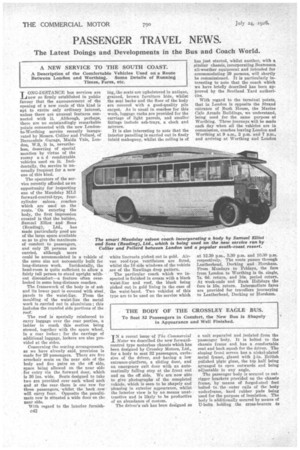PASSENGER TRAVEL NEWS.
Page 64

If you've noticed an error in this article please click here to report it so we can fix it.
The Latest Doings and Developments in the Bus and Coach World.
A NEW SERVICE TO THE SOUTH COAST.
A Description of the Comfortable Vehicles Used on a Route Between London and Worthing. Some Details of Running Times, Fares, etc.
T ONG-DISTANCE bus services are 1.1 now so firmly established in public favour that the announcement of the opening of a new route of this kind is apt to excite only ordinary interest, unless there are unusual features connected with it. Although, perhaps, there are no outstandingly remarkable points connected with the new Londonto-Worthing service recently inaugurated by Messrs. Collier and Pollard, of
Barnesdale Garage, Maida Vale, London, W.9, it is,, neverthe less, deserving of special mention by virtue of the roomy a a d comfortable
vehicles used on it. Incidentally, the service is unusually frequent for a new one of this kind.
The operators of the service recently afforded us an opportunity for inspecting one of the Mandalay ML3 forward-control-type, four cylinder saloon coaches which are used on the route. 'On entering the
body, the first impression created is that the builder, Samuel Elliot and Sons (Reading), Ltd., has made particularly good use of the large space available so as to give the maximum
of comfort to passengers, and only 26 persons are carried, although more could be accommodated in a vehicle of the same size not necessarily built for long-distance work. Incidentally, the head-room is quite sufficient to allow a fairly tall person to stand upright without discomfort—a feature often overlooked in some long-distance coaches.
The framework of the body is of ash and its lower part is covered with steel. panels to the waist-line. From the moulding of the waist-line the metal work is carried out in aluminium; this includes the rounded side portions of the roof.
The roof is specially reinforced to carry luggage over the rear portion, a ladder to reach this section being stowed, together with the spare wheel, in a roar locker ; for the carriage of additional luggage, lockers are also provided at the sides.
Concerning the seating arrangements, as we have already said, provision is
made for 26 passengers. There are five armchair seats on the near side of the body and five pairs on the off side, space being allowed on the near side for entry via the forward door, which
is 30 ins. wide. Seats designed to take two are provided over each wheel arch and at the rear there is one row for three passengers, whilst the back row
will carry four. Opposite the penultimate row is situated a wide door on the near side.
With regard to the interior furnish
ing,the seats are upholstered in antique, grained, brown furniture hide, whilst the seat backs and the floor of the body are covered with a good-quality pile carpet. As is usual in coaches for this work, luggage racks are provided for the carriage of light parcels, and smaller fittings include ash-trays, a clock and mirrors.
It is also interesting to note that the interior panelling is carried out in finely inlaid mahogany, whilst the ceiling is of white lincrusta picked out in gold. Airvac roof-type ventilators are fitted, whilst the 16 side windows of the vehicle are of the Rawlings drop pattern.
The particular coach which we inspected is finished in cream -with a black waist-line and roof, the black being picked out in gold lining in the case of the waist-band. Two vehicles of this type are to be used on the service which has just started, whilst another, with a similar chassis, incorporating Beatonson all-weather equipment and intended for accommodating 29 persons, will shortly be commissioned. It is particularly interesting to note that the coach which we have briefly described has been approved by the Scotland Yard authorities.
With regard to the terminal points, that in London is opposite the Strand entrance of Bush House, the Marine Cafe Arcade Buildings, we understand, being used for the same purpose at Worthing. Three journeys will be made each day when all the vehicles are in commission, coaches leaving London and Worthing at 9 a.m., 2 p.m. and 7 p.m., and arriving at Worthing and London at 12.30 p.m., 5.30 p.m. and 10.30 p.m. respectively. The route passes through Leatherhead, Dorking and Horsham. From Mondays to Fridays, the fare from London to Worthing is 6s. single, 7s. 6d, return, and 10s. period return. At week-ends and Bank Holidays the fare is 10s. return. Intermediate fares are provided for travellers journeying to Leatherhead, Dorking or Horsham.












































































































